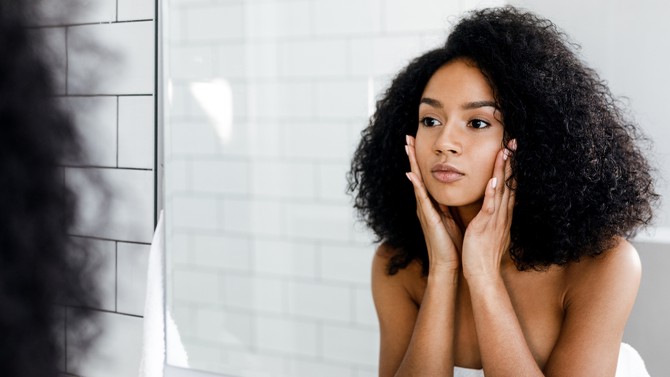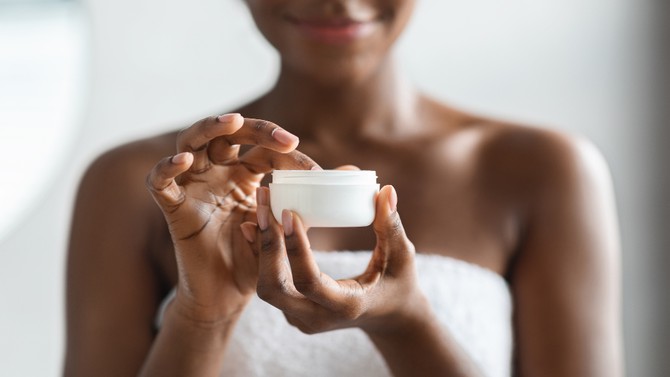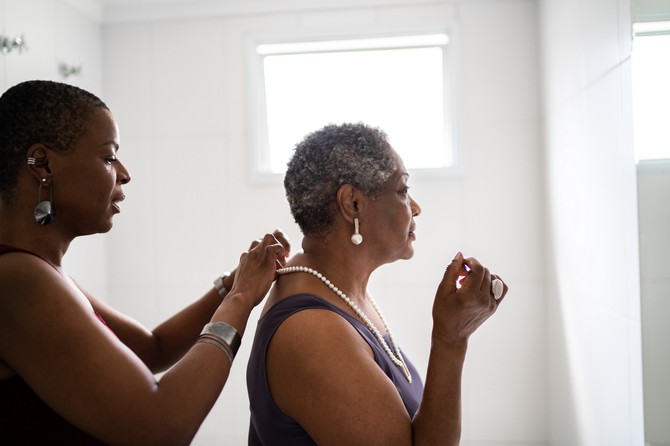4 Ages When Your Skin Changes—and What to Do About It
Are they welcome changes? Not exactly. But we've got expert advice to help you manage and minimize them.
By Emma Haak

Photo: Artem Varnitsin/Canva
AGE: 28-ish
Change #1: Your acne. It's still here (sorry), but it's different than it was in your teens and even your early-to-mid 20s. "The late 20s is when women start to see hormonal acne—deep, cystic bumps in the chin and jawline area," says Lauren Ploch, MD, an Augusta, Georgia-based board-certified dermatologist and Fellow of the American Academy of Dermatology. The drying products you used to smother your whiteheads won't work as well on these hormonal breakouts, says Ploch.
What to do about it: Topical exfoliators, such as retinoids, can help, but sometimes oral antibiotics may be necessary to really get these breakouts under control, says Anne Chapas, MD, a clinical instructor of dermatology at Mount Sinai Medical Center and the founder of Union Square Laser Dermatology in New York. Talk to your dermatologist about what she'd recommend for you.
Change #2: The wrinkles you get when you smile or frown seem to be more visible, even when you're resting your face. It used to be that those lines would vanish whenever you weren't being expressive, but Ploch says this is the time when patients start to notice that they're becoming a little more permanent.
What to do about it: If you really want to put the kibosh on wrinkles for the long term and you're willing to commit to ongoing maintenance, you may want to consider Botox, says Ploch. But if you're looking for a less invasive option (because we get it, even though many women choose to do it, you may not be ready for the cost or commitment involved with starting Botox in your 20s), topical wrinkle-smoothers, such as retinoids, can help. (Some people find retinoids to be irritating, so start with gentler over-the-counter options, see how your skin responds and then ask your dermatologist if she'd recommend moving up to a prescription-strength version.)
What to do about it: Topical exfoliators, such as retinoids, can help, but sometimes oral antibiotics may be necessary to really get these breakouts under control, says Anne Chapas, MD, a clinical instructor of dermatology at Mount Sinai Medical Center and the founder of Union Square Laser Dermatology in New York. Talk to your dermatologist about what she'd recommend for you.
Change #2: The wrinkles you get when you smile or frown seem to be more visible, even when you're resting your face. It used to be that those lines would vanish whenever you weren't being expressive, but Ploch says this is the time when patients start to notice that they're becoming a little more permanent.
What to do about it: If you really want to put the kibosh on wrinkles for the long term and you're willing to commit to ongoing maintenance, you may want to consider Botox, says Ploch. But if you're looking for a less invasive option (because we get it, even though many women choose to do it, you may not be ready for the cost or commitment involved with starting Botox in your 20s), topical wrinkle-smoothers, such as retinoids, can help. (Some people find retinoids to be irritating, so start with gentler over-the-counter options, see how your skin responds and then ask your dermatologist if she'd recommend moving up to a prescription-strength version.)

Photo: Monkey Business Images/Canva
AGE: 35 or so
Change #1: Volume loss, especially in the lower half of your face, says Ploch; plus, the wrinkles of your 20s seem to be getting a little deeper.
What to do about it: Plumping moisturizers, like those with hyaluronic acid, can help give skin a temporary fuller, smoother look. It's also a good idea to keep up the retinoid routine that you started in your 20s. If you're seeing serious volume changes or wrinkles (like if you've recently lost a significant amount of weight, which could add to these facial changes), fillers may be your best bet. "You don't need a ton, just enough to look refreshed," says Ploch.
Change #2: Dark spots brought on by sun exposure. Ploch notes that her patients used to notice these in their 40s, but that she sees more patients finding them a little younger, possibly because todays 30-somethings may have visited tanning salons more frequently than older generations did.
What to do about it: For sun spots, topical products containing vitamin C or retinoids are best, says Chapas. (Vitamin C helps fade the spots, while retinoids help exfoliate spotted layers away to reveal new skin underneath.)
Change #3: Your complexion seems dull, and here's why: Your cells are turning over more slowly, meaning dead (read: less glowy) cells are staying on the surface of your skin longer. "When we're kids, our cells turn over every 28 days," says Ploch. "By our late 30s, they're turning over every 45 days."
What to do about it: Look for the key ingredients alpha hydroxy and glycolic acids in your products, both of which help speed up skin-cell turnover to expose newer, younger skin underneath. Retinoids can also help with this job.
What to do about it: Plumping moisturizers, like those with hyaluronic acid, can help give skin a temporary fuller, smoother look. It's also a good idea to keep up the retinoid routine that you started in your 20s. If you're seeing serious volume changes or wrinkles (like if you've recently lost a significant amount of weight, which could add to these facial changes), fillers may be your best bet. "You don't need a ton, just enough to look refreshed," says Ploch.
Change #2: Dark spots brought on by sun exposure. Ploch notes that her patients used to notice these in their 40s, but that she sees more patients finding them a little younger, possibly because todays 30-somethings may have visited tanning salons more frequently than older generations did.
What to do about it: For sun spots, topical products containing vitamin C or retinoids are best, says Chapas. (Vitamin C helps fade the spots, while retinoids help exfoliate spotted layers away to reveal new skin underneath.)
Change #3: Your complexion seems dull, and here's why: Your cells are turning over more slowly, meaning dead (read: less glowy) cells are staying on the surface of your skin longer. "When we're kids, our cells turn over every 28 days," says Ploch. "By our late 30s, they're turning over every 45 days."
What to do about it: Look for the key ingredients alpha hydroxy and glycolic acids in your products, both of which help speed up skin-cell turnover to expose newer, younger skin underneath. Retinoids can also help with this job.

Photo: Prostock-studio/Canva
AGE: Around 46
Change #1: Dryness. Perimenopause begins in the 40s, and when estrogen levels start to drop, your skin begins to feel like the Sahara.
What to do about it: Moisturize like it's your job. Products with hyaluronic acid are a good choice, because the acid pulls additional water into your skin for both hydrating and plumping effects.
Change #2: Your skin seems droopier, for a number of reasons. During perimenopause, facial-volume loss really starts to become noticeable, skin naturally becomes less elastic and you're beginning to lose some bone density in your face, says Ploch. (Yup, it's a triple whammy of terribleness.) "The eye sockets may get a little wider, so your eyes look a bit sunken, and we also see it around the skin and jawline, which can make that area look saggier."
What to do about it: Plumping products and products that boost collagen production (like retinoids) can offer some help for droopiness and sunkenness. In-office treatments, such as ultrasound and micro-needling procedures, can help tighten up loose skin, says Chapas. As for that bone loss, there are some fillers on the market that can be injected right onto existing bone to help regain some of your old bone structure, says Ploch. Beyond that, make sure you're taking in enough calcium to keep existing bone strong. At this age, you need 1,000 mg per day.
What to do about it: Moisturize like it's your job. Products with hyaluronic acid are a good choice, because the acid pulls additional water into your skin for both hydrating and plumping effects.
Change #2: Your skin seems droopier, for a number of reasons. During perimenopause, facial-volume loss really starts to become noticeable, skin naturally becomes less elastic and you're beginning to lose some bone density in your face, says Ploch. (Yup, it's a triple whammy of terribleness.) "The eye sockets may get a little wider, so your eyes look a bit sunken, and we also see it around the skin and jawline, which can make that area look saggier."
What to do about it: Plumping products and products that boost collagen production (like retinoids) can offer some help for droopiness and sunkenness. In-office treatments, such as ultrasound and micro-needling procedures, can help tighten up loose skin, says Chapas. As for that bone loss, there are some fillers on the market that can be injected right onto existing bone to help regain some of your old bone structure, says Ploch. Beyond that, make sure you're taking in enough calcium to keep existing bone strong. At this age, you need 1,000 mg per day.

Photo: FG Trade/Getty Images
AGE: 50-something
Change #1: To paraphrase from Nora Ephron: You may feel bad about your neck, post-menopause. "This is the age when women start to ask what they can do about that area," says Ploch, either how they can reduce excess fat under the chin or tighten saggy skin.
What to do about it: Most firming neck creams are better at preventing neck droop than fixing it, says Ploch. In-office treatments, such as ultrasound, which can tighten skin by several millimeters, and Kybella, an injectable that dissolves fat under the chin and helps with skin tightening, are more effective options.
Change #2: Your wrinkles have turned to folds, especially if, up to this point, your idea of wrinkle management has mostly consisted of hoping and wishing they'd go away. Dry postmenopausal skin plays a role in this, too, because dehydrated, crepey skin is more susceptible to wrinkling.
What to do about it: If you've got deep wrinkles or folds, topical products probably won't help, says Ploch. Your better bets are in-office options, including ablative laser procedures and micro-needling, which stimulates natural collagen production to help smooth out wrinkles.
Want more stories like this delivered straight to your inbox? Sign up for one or more of OWN's free newsletters!
What to do about it: Most firming neck creams are better at preventing neck droop than fixing it, says Ploch. In-office treatments, such as ultrasound, which can tighten skin by several millimeters, and Kybella, an injectable that dissolves fat under the chin and helps with skin tightening, are more effective options.
Change #2: Your wrinkles have turned to folds, especially if, up to this point, your idea of wrinkle management has mostly consisted of hoping and wishing they'd go away. Dry postmenopausal skin plays a role in this, too, because dehydrated, crepey skin is more susceptible to wrinkling.
What to do about it: If you've got deep wrinkles or folds, topical products probably won't help, says Ploch. Your better bets are in-office options, including ablative laser procedures and micro-needling, which stimulates natural collagen production to help smooth out wrinkles.
Want more stories like this delivered straight to your inbox? Sign up for one or more of OWN's free newsletters!
Published 12/06/2016

